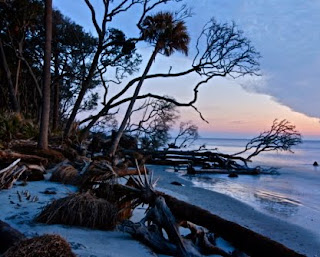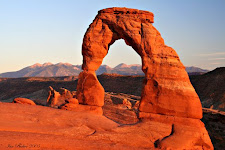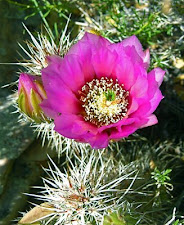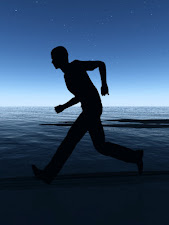 Right after you pass the steaming Volcano, the one with kids running around on it, waving putters above their heads like little Lords of the Flies. Right after the window full of beach balls and boogie boards that looks like an oversized gumball machine and the giant, neon crab blinking his claws at you… Route 17 South suddenly goes dark. This is the beginning of Brookgreen Gardens State Park - nine thousand acres of forest, meadows and gardens that act as a buffer - a sort of demilitarized zone - between the tacky, plastic free-for-all of Myrtle Beach and the quiet, natural magic of the South Carolina Low Country.
Right after you pass the steaming Volcano, the one with kids running around on it, waving putters above their heads like little Lords of the Flies. Right after the window full of beach balls and boogie boards that looks like an oversized gumball machine and the giant, neon crab blinking his claws at you… Route 17 South suddenly goes dark. This is the beginning of Brookgreen Gardens State Park - nine thousand acres of forest, meadows and gardens that act as a buffer - a sort of demilitarized zone - between the tacky, plastic free-for-all of Myrtle Beach and the quiet, natural magic of the South Carolina Low Country.The Low Country - a sportsman’s, history buff’s, nature lover’s and culinary enthusiast’s paradise - gets its name both from its geographical location at the bottom of South Carolina, and the fact that, at zero elevation, it can barely keep its chin above water. Here the continental shelf extends offshore for eighty miles and as the deep waters of the Atlantic flow in over that shallow plateau they just keep going… inland for fifty miles in some places, creating vast waterways and tidal marshes. All of this open water and shoreline makes it difficult to identify exactly what constitutes the South Carolina Coast. It is truly easier to think of it as one big coastal area or, literally, a low country - South Carolina’s version of the Bayou.
The area is rich with Civil War and pre-Civil War history - namely forts, battlefields and plantations and just past Brookgreen Gardens, on a meandering, side road in Pawley’s Island, is Litchfield Plantation. Litchfield (1754) is remarkable
 not only for its beautiful restoration, but also the fact that you can stay in it. There are four rooms in the main house and many smaller houses and cottages spread throughout the property making it ideal for both romantic couples and groups of golfers. Being among the latter, I was immediately in awe of Litchfield for its Augusta National-like entry drive. I arrived at night and the white columns and huge front steps of the main house were glowing at the end of a tunnel of interwoven oaks. Bobby Jones and Clifford Roberts might roll over in their graves when I say this, but I was more impressed with Litchfield Plantation’s Avenue of Live Oaks than Augusta National’s Magnolia Lane.
not only for its beautiful restoration, but also the fact that you can stay in it. There are four rooms in the main house and many smaller houses and cottages spread throughout the property making it ideal for both romantic couples and groups of golfers. Being among the latter, I was immediately in awe of Litchfield for its Augusta National-like entry drive. I arrived at night and the white columns and huge front steps of the main house were glowing at the end of a tunnel of interwoven oaks. Bobby Jones and Clifford Roberts might roll over in their graves when I say this, but I was more impressed with Litchfield Plantation’s Avenue of Live Oaks than Augusta National’s Magnolia Lane.In addition to its rare historic accommodations, Litchfield also has an elegant, highly-regarded restaurant, the Carriage House, but as it was late and I was alone I opted for a more boisterous, social option just down the street. Frank’s is a Pawley’s Island institution. The main restaurant was originally a grocery store run by the current owner’s grandparents. The garden and carriage house in the back have also been transformed - into an outdoor patio bar and restaurant that serves great steaks and seafood accompanied by live music and a roaring fire. I arrived alone but by the end of an exceptional gorgonzola stuffed filet and a couple of impressive glasses of Fire Truck meritage I’d made some new friends.
After Frank’s closed at midnight we headed across the street to another local favorite - the Pawley’s Island Tavern. The PIT, as it is affectionately known, is an old wooden house at the end of a sandy lane. They regularly feature live music inside, but that night there was an even more impressive act playing in the parking lot. A young fellow was sitting in the back of his pick-up truck with a lap steel guitar known as a dobro. He played so well - his metal slide flashing across the strings to keep up with his lightning fast fingers - that a crowd gathered and two other fellows grabbed their guitars and hopped up onto the truck to join him. We all raised our beers and sang along.
The next day came a little early and I got pleasantly lost trying to find my way out of Litchfield’s sprawling grounds - a kind woman painting under a bearded oak pointed her brush in the right direction. I’d come here for golf and the options are many (courses literally surround Litchfield Plantation), but I’d made a tee time at the nearby Pawley’s Plantation because I knew the back nine ran out along the marsh and I wanted to see it up close and personal. Pawley’s front nine is a very good, traditional (if somewhat uninspiring) test. A typical Jack Nicklaus design, it requires very accurate driving. But at number 13 the back nine opens up onto the
 marsh in spectacular fashion - a short par three with a tiny island green and views across the inland waterway to the barrier island where beach houses on stilts are silhouetted against the soft Atlantic light. From there in it is one marshy hole after another with snowy egrets and blue herons standing like statues on stick legs in the razor grass. And at seventeen you are forced to carry the marsh - from the back tees, over two hundred yards - presumably you are ready for the challenge by then. If not, there’s always the consolation of the cold, vodka-spiked iced tea called Firefly that awaits on the terrace behind the 18th green.
marsh in spectacular fashion - a short par three with a tiny island green and views across the inland waterway to the barrier island where beach houses on stilts are silhouetted against the soft Atlantic light. From there in it is one marshy hole after another with snowy egrets and blue herons standing like statues on stick legs in the razor grass. And at seventeen you are forced to carry the marsh - from the back tees, over two hundred yards - presumably you are ready for the challenge by then. If not, there’s always the consolation of the cold, vodka-spiked iced tea called Firefly that awaits on the terrace behind the 18th green.It’s only two hours to Charleston and once you cross over the river into Georgetown all pretension of tourism evaporates. When the road descends from the bridge it passes right between a paper mill and an iron foundry. A huge sixteen wheeler loaded with freshly hewn trees made a slow, wide right turn in front of me. From there on it is just a windows down, pine-scented cruise. Women sell handwoven baskets - a low country specialty - along the roadside as farm fields and general stores flow past in slow glory. And when they say general store here… they mean general. I stopped at the Seewee Outpost near Bull Island and was tempted to buy an ice-cream cone, a beach ball, a jug of kerosene and a box of ammo just to see the expression on the cashier’s face. But something tells me he wouldn’t have raised an eyebrow… that’s just an average daily purchase here. More than anything I wanted to buy a trucker’s hat that said, “Seewee Outpost” on it, because that’s exactly the kind of authentic local accessory that is coveted these days in hipster places like Austin and LA. I settled for a sandwich and an iced-tea (the non-alcoholic kind.)
With the Seewee Outpost barely out of my rearview mirror, Charleston arrived in surprising millennial style, its new, gleaming white Cooper River bridge rising skyward - the towers and cable stays like a modern sculpture of two hands playing cat’s cradle. It’s an interesting landmark for a town so steeped in history - this is where the first shots of the Civil War were fired. And as you drive over the bridge you can see Fort Sumpter way out at the mouth of the harbor to prove it.
I met my mother in Charleston so it was all garden and house tours for us, which might’ve been less interesting except for the fact that every house here is a living museum. We even unexpectedly found ourselves in a house in the fictional Catfish Row (really Cabbage Row) where DuBose Heyward wrote Porgy which later, with Gershwin’s help, became Porgy and Bess. As a writer, this pleased me very much and it wasn’t hard to imagine how these beautiful inner courtyards and gardens could inspire a play or a novel… they remind me of tidier versions of the houses in New Orleans’ French Quarter.
Finding a good place to eat in Charleston is difficult only because there are so many fine restaurants and everyone will recommend something different. Let me just say that my mother and I loved The Peninsula Grill in the Planter’s Inn (also one of the best places to stay) so much that we went back for a second time on our last night. The place is super fine dining with prices to match, but it is worth every
 penny (if you accidentally drop a crumb, its gone before it hits the table…I tried it just for fun.) The decor is European, with portraits of historic Charleston figures, white table cloths and upholstered banquettes, but it is anything but stuffy. The food is consistently well prepared - everything is seasonal so it’s hard to recommend specific dishes, but if you are lucky enough to be there when soft-shelled crabs are in season you might want to return every night for them (we had them elsewhere and they couldn’t compare.)
penny (if you accidentally drop a crumb, its gone before it hits the table…I tried it just for fun.) The decor is European, with portraits of historic Charleston figures, white table cloths and upholstered banquettes, but it is anything but stuffy. The food is consistently well prepared - everything is seasonal so it’s hard to recommend specific dishes, but if you are lucky enough to be there when soft-shelled crabs are in season you might want to return every night for them (we had them elsewhere and they couldn’t compare.)Of all the other places we ate I recommend High Cotton for dinner - especially the buttermilk oysters - and if it’s just two of you, request table 28 in the corner by the window where they filmed a scene from The Notebook. For a daytime snack with a view of the city go to the rooftop at the Market Pavillion Hotel (shrimp salad), for an evening drink with an even more stunning view go to the very tippy top of the Vendue Lounge and for breakfast try Toast on Meeting Street. As for my favorite Inn - stay at Two Meeting Street, a gorgeous historic mansion with nine rooms, gardens and a veranda overlooking the water out on the South Battery.
We decided to go Plantation hopping and there are three in a row about 45 minutes south of town: Drayton Hall, Magnolia and Middleton. Drayton is unique in that the plantation house itself is completely unfurnished and offers a barebones, authentic look at the modest early American version of Palladian architecture. In contrast, Boone Plantation to the north of the city goes for the full Williamsburg-style reenactment. The other two down by Drayton are known more for their gardens, azaleas in particular, and feature crowded, over-explanatory wagon tours that some people love. You know who you are. To me at least one or two of these are worth visiting just for the experience of walking around among the oaks and along the marshes - to smell the air and feel the brittle Bermuda grass beneath your feet - to get a visceral sense of where you are, something driving or walking around the city simply can’t provide.
Charleston is a peninsula - shaped a little like Manhattan with the Cooper and Ashley Rivers on either side. The two barrier islands that form the mouth of the harbor, Isle of Palms and Folly Beach, each have their own individual character. Isle of Palms in particular is worthy of a day trip - there are lots of great places to eat on the water and Sullivan’s Island is a very nice beach. But if you want to be flat out wowed, head a couple of islands further south to Kiawah Island. The
 drive alone is worth it - running through miles of marshes and horse farms and Oak groves. And just after you turn left off of Maybank Highway onto the road to Kiawah, you will find a dirt road on the right that leads to Angel Oak, a sprawling dinosaur of a tree whose thick wooden tentacles look like one of those fantastical old drawings of a giant squid taking down a whaling ship. The actual age of the tree is a topic of debate, but the rumors of 1500 years seem completely plausible. It is that big.
drive alone is worth it - running through miles of marshes and horse farms and Oak groves. And just after you turn left off of Maybank Highway onto the road to Kiawah, you will find a dirt road on the right that leads to Angel Oak, a sprawling dinosaur of a tree whose thick wooden tentacles look like one of those fantastical old drawings of a giant squid taking down a whaling ship. The actual age of the tree is a topic of debate, but the rumors of 1500 years seem completely plausible. It is that big.Kiawah itself is known for two things, the beach and golf, and both are in a league of their own. Kiawah is a hush-hush, super wealthy enclave of golf courses and housing communities spread out over many, many miles of islands and marsh. It is massive. If you’re driving to the Ocean Course and think you missed it, you didn’t. Keep going and try not to drive off the road as you gawk at the vistas of open water, razor grass, winging herons and little wooded islets and bleached skeletons of deadwood. The place is like an oil painting.
I discovered two ways to enjoy the beach here. One is to play the Ocean Course - an extremely sophisticated, difficult and beautiful Pete Dye design that runs right along the beach. Your (astronomical) greens fee entitles you access to the locker room (with showers) so bring a beach bag, stroll right across the practice green in front of the clubhouse to the beach after the round and if you have any legs left, hike north out to the point beyond the 5th tee. The powder white dunes, seabirds, clashing currents and solitude will erase any care (even the memory of the dozen balls you just lost in the marsh.) The other way is to have lunch by the pool at the Sanctuary Hotel. This doesn’t gain you access to the pool itself or any of the terry cloth covered lounge chairs around it, but nothing is stopping you from walking right off the pool deck onto the beach. So again, just pack a little beach bag, enjoy the day, and rinse off afterwards under the outdoor shower by the stairs that lead back to the pool. Or pay $500 for a room and join the beautiful people sunning themselves everywhere in self-confident repose.
After Kiawah I headed another two hours south to Beaufort, a town that is historically significant for being where the southern states signed the Declaration of Secession to begin the War Between the States. It is also historically significant because Sherman in his victorious and destructive march south did not burn the town so it has one of the finest collections of pre-Civil War houses in the south. It is thirdly famous for being the site of the movie The Prince of Tides, in particular the opening scene where the young boy runs and jumps off of the wooden dock into the water… that was shot on Lady’s Island just across the drawbridge from downtown.
When I drove into Beaufort in the late afternoon the tide was out in the gigantic marsh alongside Boundary Road and it was actually a frightening sight. It looked like I imagine the seabed looks right before a Tsunami strikes - an unnatural draining that reveals to the air parts of the world that are meant to remain submerged. This is the bottom of the earth. The heart of the Low Country.
This is the place to get down and dirty so I passed on Plum’s, an airy, pleasant waterfront cafe on Bay Street (highly recommended) and opted instead for Steamer Oyster and Steakhouse just over the drawbridge - a grey wooden shed of a building with picnic tables inside where they serve buckets of steaming local oysters with the mud still on them and heaping plates of Frogmore Stew - mouth popping local shrimp mixed with sausage, potatoes, green peppers and onions.
Then instead of staying in a nice guest house like the Beaufort Inn, I kept driving out towards the coast through the little town Frogmore itself (where you will find the lovely little Red Piano Too art gallery) past the fleets of Shrimp boats moored in the marsh, past the fried shrimp and oyster stands and dilapidated buildings that are being slowly reclaimed by the humidity and salt, all the way out to Hunting Island State Park where I camped right on the beach in the shadows of a dense, dark oak forest. When the surf is up here, the waves actually crash right into the forest and there are jagged, water-logged stumps sticking out of the sand where trees once stood. There is a lighthouse here to climb and miles of walking trails which are especially beautiful at night when the moonlight filters down through the dense canopy.
You can go further south and still be in South Carolina, but then you will be in Hilton Head among hundreds of golf courses and gated retirement communities and chain restaurants. If you are looking for the soul of the Low Country stop here. As much as I love to play golf, I decided not to spoil the moment. I took one last deep breath of the salt and Spanish moss and primordial marsh. Then I turned around and headed back north.






















.jpg)





No comments:
Post a Comment